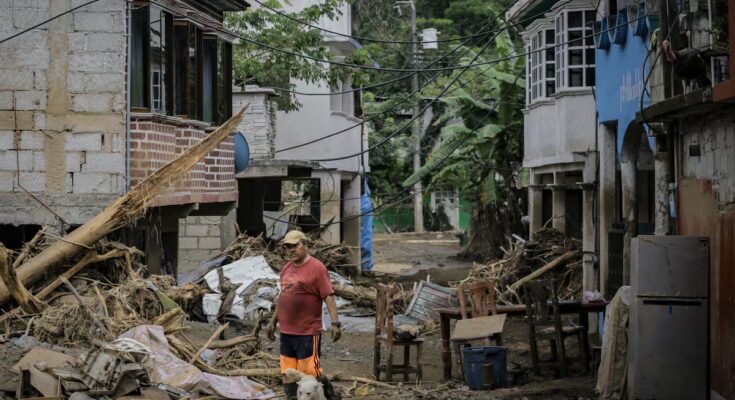Of 200 inhabitants, only six now remain. Everyone else left Chapula, a community in Hidalgo’s Huasteca region, once surrounded by a river and one of the hardest hit by Hurricane Priscilla a month ago. Torrential rains buried the city with a force that, say those who decided to rebuild it from scratch, “hadn’t been seen for 100 years”. Raúl Jiménez Montiel, a 50-year-old man who works in the fields, keeps watch at the entrance to the town, which belongs to the municipality of Tianguistengo, while some families return only to save from their homes what little the water and mud have left. There are still those who maintain the hope of reviving a population left without communications, electricity or basic services.
The only way to get to Chapula now is on horseback or by walking through the mountains, a journey that can take more than three hours of walking from the nearest point. Many of its inhabitants, resigned, did not return after the rains. But Zoralia Cruz Hernández, 32, did not want to leave behind two things that were fundamental to her: a figure of about one meter of San Judas Tadeo, who she said always took care of her, and her animals, including two sows. One of them is close to giving birth. In addition to the surviving pigs, dogs, some ducks and chickens, they are now starting to claim the city streets as their own, as there is no way to get them out of there.
Due to the difficulty of entering and exiting Chapula, Zury – as he is affectionately called in the village – has no choice but to resign himself to leaving “his little pig” there, but at least protected inside his own home. “I struggled with her, because I always took care of her. It hurts, because she was out and alone and she’s having piglets,” says the woman who raised pigs, as she massaged the animal’s pregnant belly. Trying to hold back tears for all that has been lost and facing the vision of his house all muddy, he remembers that the rains had almost taken away his Lupita. “A while ago I came bringing food to feed them because for me they are part of me. I have been taking care of her for a while and I don’t like leaving her alone,” she says of her pig.
Next to her there are still Alberto and his sister Edith. I’m one of the few. They are trying to get their business back on its feet so the community has a chance to survive, even though it has been declared uninhabitable by the Mexican authorities. Given the damage to Chapula, the balance tips more toward starting from scratch elsewhere than toward rebuilding. But the brothers are reluctant to give up their Mojarra farm. The water took it away and left only a small dam full of mud. “We came to collect the remaining little fish,” says Edith. Like them, the few who have returned to the village are trying to bring back to life the lands that were once cultivated with corn, pumpkin and beans and which today are strewn with stones and mud. “We had to come and see what was left because, poor mojarras, some were still here in the mud,” adds Beto, the nickname by which his older brother is known. For Don Antonio Bautista Hernández, a 54-year-old corn farmer, the rains took away what he had managed to build after migrating and returning to Chapula: a house and a land where until a month ago he gathered hope.
The governor of Hidalgo state, Julio Menchaca Salazar, announced that the city of Chapula has been declared an uninhabitable zone after rains in the mountains, indicating that “there are no more houses” in this community. Its few inhabitants complain that they have not been officially informed and are reluctant to leave their belongings behind. Among these, Don Nabor Hernández Montiel, a 57-year-old rancher and farmer who served as a guide for much of this EL PAÍS tour. In his efforts to reclaim city life, he comes and goes up to three times a day for cleaning jobs and to retrieve his belongings. The descent takes an hour and a half, but the ascent takes more than three hours from Pemuxco, the nearest town.

There are helicopters coming down to bring water and some food, but no other type of help arrives nor have the hands that helped the inhabitants remove the mud in the first days returned. There is no road access, no electricity, no telephone signal.
Don Antonio is – together with Edith, Raúl, Rey, Maximina and his older brother Beto – one of the last six permanent inhabitants of Chapula. They are organizing to form a commission to present their case to the authorities in an attempt to defend their lands and their existence as a community. They say they are willing to risk their lives if this type of torrential, inclement weather were to happen again. Other neighbors make the trip back and forth as they retrieve their belongings or keep their animals alive, but they no longer settle in town. The scene, they admit, was experienced with desolation. Chapula was a city full of life, with a suspension bridge adorning the river crossing and large pools in which its inhabitants swam and enjoyed nature.
Today only the memory of that remains. The roads remain covered in mud, increasingly drier, and the bridge is just a high tension cable that those who wish to cross the river hold on to without being carried away by the current. The clear water from before is still brown and still flows with an overwhelming force that discourages the return of those who survived. The Chapula six feel condemned to disappear, but they declare themselves resistant.



